PCVR headsets connect directly to your gaming PC’s power supply, giving you unlimited playtime without battery concerns. Standalone headsets rely on internal batteries that typically last 2-3 hours depending on game intensity and settings like brightness or passthrough features. You’ll face 2.5-hour charging cycles with standalone devices, creating mandatory downtime between sessions. PCVR systems consume 300+ watts but eliminate power management worries, while standalone units optimize mobile hardware for energy efficiency. Strategic optimization techniques can greatly extend your VR sessions.
Power Source Dependencies Between PCVR and Standalone Systems

The fundamental difference between PCVR and standalone VR systems lies in their power architecture.
PCVR harnesses your computer’s direct power connection while standalone VR relies on limited internal batteries for operation.
When you’re using PCVR headsets, you’re tapping directly into your powerful gaming PC’s electrical supply, eliminating battery life concerns entirely. This connection enables unlimited playtime sessions without interruption, as long as your computer remains powered.
Your standalone VR headsets operate differently, relying on internal batteries that typically last 2-3 hours depending on your VR experience intensity. You’ll need effective power management strategies for extended sessions with standalone devices.
While standalone systems offer portability, they sacrifice processing power due to battery constraints. PCVR systems leverage your PC’s full processing power capabilities, delivering superior performance without worrying about depleting batteries during gameplay.
Battery Drain Patterns During Extended Gaming Sessions
During intensive VR gaming sessions, your standalone headset’s battery will drain at dramatically different rates depending on what you’re playing and how you’ve configured your settings.
Games with high graphical demands will accelerate battery drain considerably, often reducing your Quest 2’s typical 2-3 hour lifespan. Mixed reality features and haptic feedback further compound this issue.
You can improve battery efficiency by adjusting display brightness and disabling passthrough cameras during gameplay. External battery packs offer extended playtime for marathon sessions.
PCVR headsets eliminate these concerns entirely since they draw power directly from your connected PC, allowing unlimited gaming sessions without battery interruptions.
This fundamental difference makes PCVR systems ideal for extended gameplay without the constant worry of power depletion affecting your standalone VR experience.
Charging Requirements and Downtime Comparisons

Beyond managing power consumption during gameplay, you’ll face significant charging requirements that create mandatory downtime with standalone headsets.
Your Oculus Quest typically delivers 2-3 hours of battery life before needing a 2.5-hour recharge cycle. This creates unavoidable interruptions that force you to plan gaming sessions around charging schedules.
PCVR eliminates these constraints entirely. Since your headset draws power directly from your PC, you won’t experience charging-related downtime.
You can enjoy continuous play for hours without battery management concerns, while standalone headset users must constantly monitor power levels.
This fundamental difference means PCVR users gain unlimited session length, whereas your standalone headset requires strategic planning around charging requirements.
The absence of battery constraints gives PCVR a clear advantage for extended gaming experiences.
Processing Load Impact on Energy Consumption
While standalone headsets optimize energy consumption through mobile-focused hardware, your VR system’s processing demands directly influence how much power it consumes during gameplay.
When you’re using standalone devices like the Quest 2, the integrated processors limit energy consumption, typically providing 2-3 hours of battery life during intensive sessions.
However, PCVR systems tell a different story. Your powerful computer’s GPU becomes the primary energy consumer, often drawing 300+ watts during graphics-intensive applications. This processing load creates significant battery drain on laptops or requires constant power outlet connection for desktops.
The trade-off is clear: while PC systems deliver superior graphics quality, standalone headsets excel in energy efficiency for mobile VR experiences.
Optimization Strategies for Maximizing VR Playtime

Since battery life remains a critical limitation for standalone VR headsets, you can implement several targeted strategies to squeeze maximum playtime from each charging session. Tweaking display settings greatly impacts power consumption—lowering brightness and resolution extends usage considerably. You’ll also want to limit haptic feedback during experiences, as this feature demands extra energy. Use passthrough sparingly since it activates cameras and processing power that drain battery faster.
| Strategy | Impact on Battery Efficiency |
|---|---|
| Lower brightness/resolution | Considerable power savings |
| Limit haptic feedback | Moderate energy conservation |
| Minimize passthrough usage | Reduces camera power drain |
| Enable power-saving modes | Extends overall playtime |
Regular software updates optimize battery management, while shorter sessions and power-saving modes further enhance your standalone VR experience duration.
Frequently Asked Questions
Can You Swap Batteries During VR Gaming Sessions Without Interrupting Gameplay?
You can’t swap batteries during gameplay on most VR headsets without interrupting your session. You’ll need to pause, power down, replace batteries, and restart. Some controllers allow hot-swapping, but headsets don’t.
Do Wireless Adapters for PCVR Headsets Significantly Reduce Overall Battery Performance?
Yes, you’ll notice wireless adapters drain your headset’s battery faster since they’re constantly transmitting high-bandwidth video data. You’ll typically get 2-3 hours less gameplay compared to wired connections.
Which VR Headset Brands Offer the Longest Battery Life in Real-World Testing?
You’ll find Quest 3 and Pico 4 deliver the longest battery life, typically lasting 2-3 hours during intensive gaming. Quest Pro and PSVR2 offer shorter sessions, while Quest 2 provides decent endurance.
How Does Room Temperature Affect VR Headset Battery Drain and Performance?
You’ll notice your VR headset’s battery drains faster in hot temperatures as processors work harder to maintain performance. Cold rooms can also reduce battery capacity, making your device shut down unexpectedly during sessions.
Are There External Battery Packs Compatible With Most Standalone VR Devices?
You’ll find several external battery packs compatible with most standalone VR headsets. They’re designed to attach to your headset’s strap or clip onto your belt, extending your gaming sessions considerably beyond standard battery life.





Leave a Reply